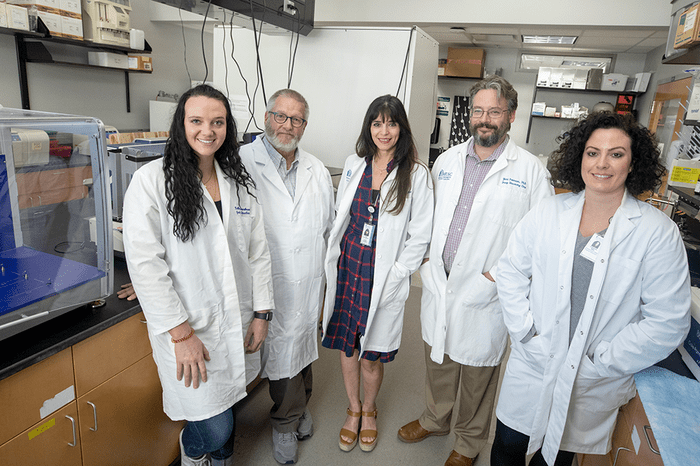A Medical University of South Carolina (MUSC) research team has developed novel compounds that show early promise at fighting the rare pediatric cancer neuroblastoma when paired with the existing anti-cancer drug bortezomib (Velcade, Takeda Oncology). The novel compounds block or inhibit an enzyme known as lysine-specific demethylase 1 (LSD1). The MUSC team, led by Patrick M. Woster, Ph.D., reports its findings in the European Journal of Medicinal Chemistry.
“Our compounds are a new chemical class of LSD1 inhibitors and are the first small molecules to produce a synergistic anti-tumor response in combination with bortezomib,” said Woster. Woster is the SmartState Endowed Chair in Drug Discovery and head of the Department of Drug Discovery and Biomedical Sciences at MUSC.
Such combination therapies are the way of the future, said co-author Yuri Peterson, Ph.D. Peterson is assistant director of the Drug Discovery Core and director of Bioenergetics Profiling at MUSC.
“Drug development in cancer therapeutics is moving away from single toxic agents to specific combinations that are personalized according to the patient’s genetics,” said Peterson. “By using these combined therapies, we can increase the positive effect while limiting the negative effects of cancer-killing agents like bortezomib.”
Such new treatment options are urgently needed for children with high-risk disease. Current therapies are often ineffective and incredibly painful. Nearly half of these children die within five years of diagnosis.
The Woster team is keenly aware of the challenges faced by these children and motivated to provide them new options.
“We need treatments that are not only more effective against high-risk disease but that are better tolerated by patients,” said postdoctoral scholar Catherine Mills, Ph.D., first author of the article.
Woster and scientists in his laboratory are investigating compounds that block the activity of LSD1. Previous work has shown that LSD1 acts as scaffolding to support and stabilize the protein factor MYCN. This scaffolding helps tumors to form and spread, and so patients with increased MYCN tumors are considered to have high-risk disease. The Woster lab wants to disrupt that scaffolding with their novel LSD1 inhibitors.
Using resources provided by the MUSC Drug Discovery Core, the team tested the novel inhibitors alone and together with bortezomib in neuroblastoma cells with abnormally high levels of MYCN. When used together, the novel inhibitor and bortezomib were much more potent killers of these cancer cells than when either was used alone.
“Our studies are the first to show that inhibition of LSD1 is a viable strategy for targeting high-risk MYCN-amplified neuroblastoma,” said Woster.
Several LSD1 inhibitors are in clinical trials for solid tumors. However, few of them interact with LSD1 in a reversible manner. Irreversible drugs bind to their targets and never unbind, producing toxicity-related side effects.
“You can think about reversible and irreversible drugs and how they interact with a target protein in terms of a handshake,” said Mills.
“At the end of the handshake, reversible drugs allow both parties to remove their hands and go on about their business. However, with irreversible drugs, their hands remain superglued together,” she explained. “Can you imagine carrying out your day with your hand stuck to another person’s? You would lose the function of that hand. Similarly, you lose the function of the protein that is stuck to the irreversible drug, causing toxic side effects.”
The study’s findings suggest that combining a reversible and less toxic LSD1 inhibitor and bortezomib could pack a particularly powerful anti-cancer punch.
Next steps are to adjust the inhibitor to make it even more effective against high-risk neuroblastoma when combined with bortezomib.
“We plan to optimize the structure of our LSD1 inhibitor to increase its potency against LSD1 and hope that it can produce an even greater synergistic effect,” said Woster. “We also hope to test this combined approach in several other cancer types with increased MYCN.”
# # #
About MUSC
Founded in 1824 in Charleston, MUSC is the state’s only comprehensive academic health system, with a unique mission to preserve and optimize human life in South Carolina through education, research and patient care. Each year, MUSC educates more than 3,000 students in six colleges – Dental Medicine, Graduate Studies, Health Professions, Medicine, Nursing and Pharmacy – and trains more than 850 residents and fellows in its health system. MUSC brought in more than $297.8 million in research funds in fiscal year 2022, leading the state overall in research funding. For information on academic programs, visit musc.edu.
As the health care system of the Medical University of South Carolina, MUSC Health is dedicated to delivering the highest quality and safest patient care while educating and training generations of outstanding health care providers and leaders to serve the people of South Carolina and beyond. Patient care is provided at 14 hospitals with approximately 2,500 beds and five additional hospital locations in development, more than 350 telehealth sites and connectivity to patients’ homes, and nearly 750 care locations situated in all regions of South Carolina. In 2022, for the eighth consecutive year, U.S. News & World Report named MUSC Health the No. 1 hospital in South Carolina. To learn more about clinical patient services, visit muschealth.org.
MUSC and its affiliates have collective annual budgets of $5.1 billion. The nearly 25,000 MUSC team members include world-class faculty, physicians, specialty providers, scientists, students, affiliates and care team members who deliver groundbreaking education, research and patient care.
Journal
European Journal of Medicinal Chemistry
DOI
10.1016/j.ejmech.2022.114818
Method of Research
Experimental study
Subject of Research
Cells
Article Title
Synthesis and evaluation of small molecule inhibitors of LSD1 for use against MYCN-expressing neuroblastoma
Article Publication Date
7-Oct-2022
COI Statement
The authors declare the following financial interests/personal relationships which may be considered as potential competing interests:Patrick M. Woster reports financial support was provided by National Institutes of Health. Patrick M. Woster has patent #PCT/US2020/036028 pending to Medical University of South Carolina.

















